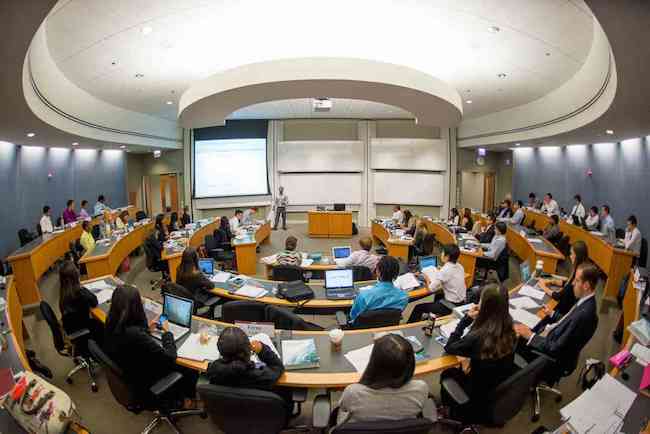FOUR OUT OF EVERY TEN EMBA STUDENTS NOW PAY THEIR OWN WAY
“Full financial sponsorship has been going downward, but the number of students who are partially funded by their employers has stayed reasonably stable,” says Michael Desiderio, executive director of the Executive MBA Council. “In terms of partial funding, some corporations have a cap and others will only reimburse the tax credit amount, so it really varies.” The group’s surveys show that 24% of EMBA students receive full financial sponsorship, 41% are fully self-funded, and 35% are partially funded.
At Chicago Booth, fully half of all the students are entirely self-funded, insuring that EMBA graduates come out with student loans in their 30s and 40s. “Unless the credential becomes less important, I don’t see the popularity of the degree declining,” says Keegan. “The networking and credential appeal of the degree are still pretty compelling reasons to come.”
The new ranking by Poets&Quants measures the overall reputation of these programs by combining the four latest ratings on EMBA programs from BusinessWeek, The Economist, The Financial Times, and U.S. News & World Report. By blending these rankings into a composite list, the methodology tends to diminish anomalies that often show up in any one rating system.
A school must be ranked on at least two of the four lists to be included. The reason? Generally, the more widely recognized an EMBA program is, the more one can be assured of its quality and brand value. Programs that eke out only a single ranking are less likely to have the cache and prestige of those that are ranked by all four or three of the most influential rankings (For a more detailed explanation of our methodology, see our guide here).
OTHER EMBAS TO CONSIDER: BERKELEY, MIT, YALE & NOTRE DAME
There are some notable and obvious exceptions. Executive MBA offerings by UC-Berkeley, MIT Sloan, and the Yale School of Management, immediately come to mind. UC-Berkeley’s EMBA was ranked ninth by U.S. News & World Report this year, but the school’s 19-month program was only launched in May of 2013 and has yet to graduate a single class.
Berkeley’s new standalone program replaced its long-time partnership EMBA with Columbia Business School. MIT didn’t graduate its first EMBA class until 2012, a reason why the program doesn’t crop up on any lists. Until only recently, Yale’s Executive MBA admit students exclusively from the healthcare sector so it was not open to all prospective students. This year, the school added asset management and sustainability in its EMBA portfolio, a move that will significantly broaden the appeal of its MBA for working professionals.
Of course, none of these rankings are without their flaws so a composite ranking tends to get a user closer to the true brand value of these programs, especially because of the absence of Harvard Business School and Stanford Graduate School of Business from the EMBA market.
A CHANGE IN THE METHODOLOGY RESULTED IN FAR MORE NON-U.S. SCHOOLS ON THE LIST
This year Poets&Quants changed its methodology to incorporate the findings of The Economist’s debut ranking of executive MBA programs last year. The Economist list replaces the now out-of-date ranking of The Wall Street Journal which last ranked business schools in 2010.
That change alone caused significant reverberations on our list for two major reasons: The Economist ranked more than twice as many programs as the Journal, 68 vs. 25, and The Economist’s list is much more global. Four years ago, only one non-U.S. school was on The Wall Street Journal’s list, IE Business School in Spain. In contrast, there are 25 standalone EMBA programs outside the U.S. ranked by The Economist.
The upshot: International programs fare much better on this year’s list. Last year, only three non-U.S. EMBA programs made our top 25. This year, there are eight, ranging from No. 4 IE Business School to No. 25 National University of Singapore. Of the 48 EMBA programs that are ranked by Poets&Quants, 15 are outside the U.S. So in many cases, the slippage of some of the best U.S. programs this year is due largely from the addition of The Economist and the subtraction of the more U.S.-centric Wall Street Journal ranking.
As always, the new ranking takes into account a blizzard of metrics to measure the quality of the programs, from surveys of student satisfaction to rises in income attributed to the degree. Each of the four major rankings are equally weighted in this 2014 survey of the best.
For the first time ever, Poets&Quants also published a separate ranking of joint EMBA programs (see Our 2014 Ranking Of The World’s Best Joint-EMBA Programs). The Kellogg School’s partnership with Hong Kong University of Science and Technology came in first among the joint programs. In fact, Kellogg partnerships with other schools in Germany and Canada were in the top five.
(See following page for our full 2014 ranking)






Questions about this article? Email us or leave a comment below.